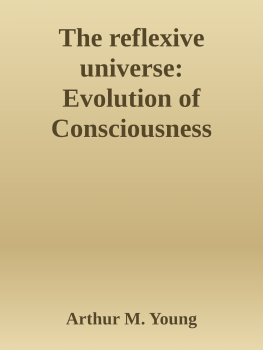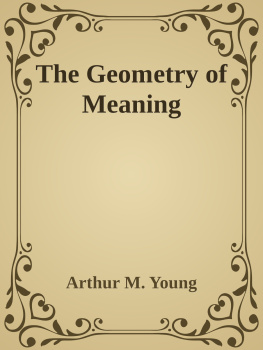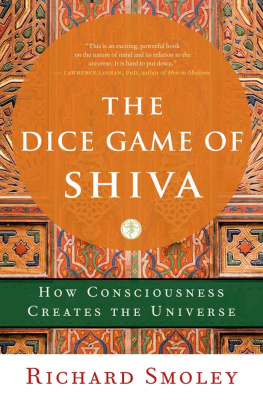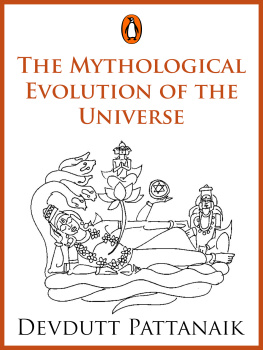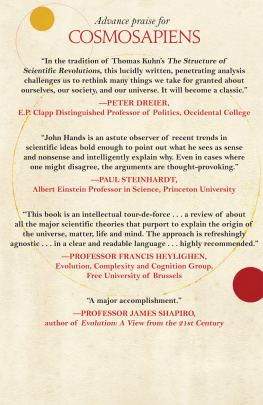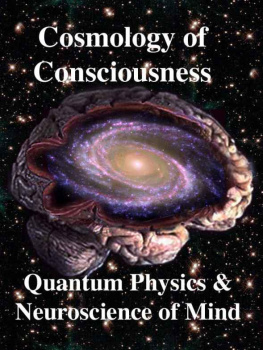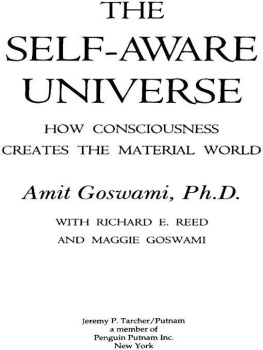Arthur M. Young - The Reflexive Universe: Evolution of Consciousness
Here you can read online Arthur M. Young - The Reflexive Universe: Evolution of Consciousness full text of the book (entire story) in english for free. Download pdf and epub, get meaning, cover and reviews about this ebook. year: 1999, publisher: Anodos Foundation
Romance novel
Science fiction
Adventure
Detective
Science
History
Home and family
Prose
Art
Politics
Computer
Non-fiction
Religion
Business
Children
Humor
Choose a favorite category and find really read worthwhile books. Enjoy immersion in the world of imagination, feel the emotions of the characters or learn something new for yourself, make an fascinating discovery.
- Book:The Reflexive Universe: Evolution of Consciousness
- Author:
- Publisher:Anodos Foundation
(first published January 1st 1976) - Genre:
- Year:1999
- Rating:5 / 5
- Favourites:Add to favourites
- Your mark:
- 100
- 1
- 2
- 3
- 4
- 5
The Reflexive Universe: Evolution of Consciousness: summary, description and annotation
We offer to read an annotation, description, summary or preface (depends on what the author of the book "The Reflexive Universe: Evolution of Consciousness" wrote himself). If you haven't found the necessary information about the book — write in the comments, we will try to find it.
The Reflexive Universe: Evolution of Consciousness — read online for free the complete book (whole text) full work
Below is the text of the book, divided by pages. System saving the place of the last page read, allows you to conveniently read the book "The Reflexive Universe: Evolution of Consciousness" online for free, without having to search again every time where you left off. Put a bookmark, and you can go to the page where you finished reading at any time.
Font size:
Interval:
Bookmark:
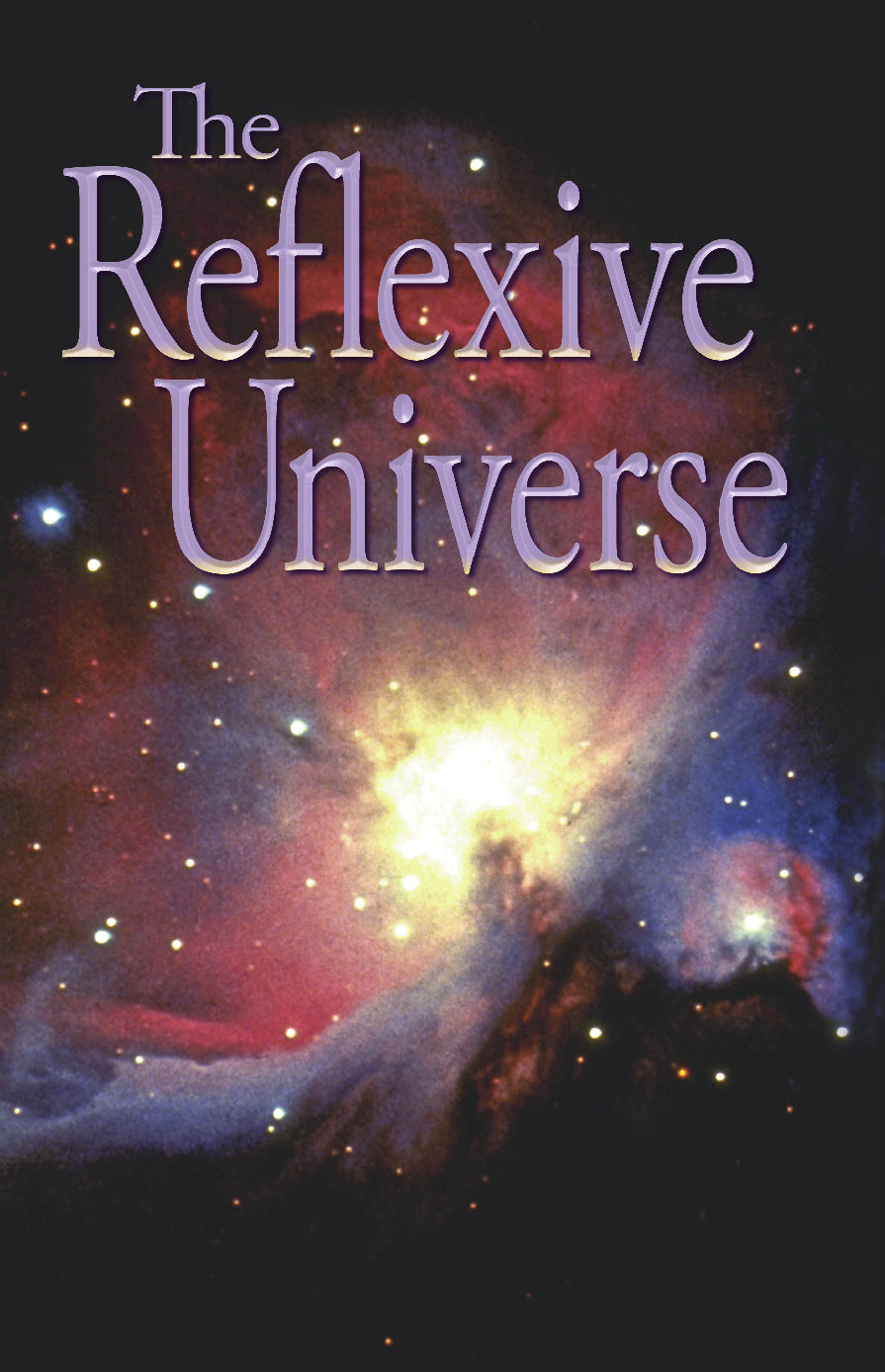
Evolution of Consciousness
Arthur
Ar
M. Young
Introduction by huston Smith
The reflexive universe
This edition of The
Reflexive Universe is
Volume I in the Anodos
Series of the collected
works of Arthur M. Young
published by Anodos
Foundation. Except for
editorial and typographical
corrections, updating of
front and back materials, and
an introduction by Huston
Smith, this eighth reprint is
a facsimile of the original
volume published by
Delacorte Press in 1976.
also by Arthur M. Young
The Geometry of Meaning
The Bell Notes
Which Way Out?
Foundations of Science
Science and Astrology
Mathematics, Physics, and
Reality
Nested Time
Arthur M. Young
The reflexive
universe
Evolution of consciousness
Anodos
Anodos Publications
Front cover: photograph of the Orion Nebula, M14. Courtesy of Corbis Images, 1999
Grateful acknowledgment is made for permission to use the following copyrighted material.
Excerpt from pp. 175-176 of Clairvoyance and Materialization by Gustav Geley: translated by Stanley Barth (1927). Used by permission of Ernest Benn Limited.
Chart of the plant kingdom from Harold C. Bold, The Plant Kingdom: 3rd edition, 1970. Reprinted by permission of Prentice-Hall, Inc., Englewood Cliffs, N.J.
Illustrations on pp. 99, 100, 101, 102, 103, 104, 106, 107, and 121 from C. A. Villee: Biology, 6th edition: Philadelphia, W. B. Saunders Company, 1972. Reproduced by permission of the author and publisher.
Illustration on p. 113 of sunflower with counterclockwise and clockwise spirals: Adapted from Mathematical Games by Martin Gardner. Copyright 1969 by Scientific American, Inc. All rights reserved.
Copyright 1976 by Arthur M. Young
All rights reserved. No part of this book may be reproduced in any form or by any means without the prior written permission of the Publisher, excepting brief quotes used in connection with reviews written specifically for inclusion in a magazine or newspaper.
Manufactured in the United States of America
Designed by Jerry Tillett
Cover design by Rocki deLlamas
Eighth edition
First publication, Kindle edition 2015
Anodos Foundation
Rural Route 1, Box 465
Cambria, CA 93428
Library of Congress Cataloging in Publication Data Young, Arthur M. 1905-1995
The reflexive universe.
A Merloyd Lawrence book.
Includes bibliographical references and index.
1. Evolution. 2. SciencePhilosophy.
3. Consciousness. I. Title.
QH371.Y68 575.01 76-2675
ISBN-10: 1-892160-15-3
ISBN-13: 978-1-892160-15-7
The reflexive universe
was orginally published by
Merloyd Lawrence
and also published by Robert Briggs Associates
The publishers wish to thank Sheila La Farge
for extensive editorial assistance
in preparing this book for publication.
Acknowledgments
In the course of rewriting this book a number of times, I have drawn on many friends for ideas, criticism, and suggestionsTed Bastin, Chris Bird, Oscar Brunler, Jean duCharm, Chris Clark, John Coggeshall, Ira Einhorn, George Hall, Charles Hapgood, David Hill, Bartram Kelley, Sheila La Farge, Payson Loomis, Mary Benzenberg Mayer, Alice Morris, Charles Muss, Ken Pelletier, Charles Price, Jeanne Rindge, Ivan Sanderson, Joan Schleicher, Eric Schroeder, Alice Schwarr, Saul Paul Sirag, Harry Smith, Vincent Smith, Nick Spies, Kelvin Van Nuys, Chycherle Waterston, Rick Werner, Chris Young, and most of all my wife, Rutheach has made a distinct contribution.
Contents
Chapter I I
Chapter II I
Chapter III I
Chapter V I
Chapter VI I
Chapter VII I
Chapter VIII I
Chapter IX I
Chapter X I
Chapter XI I
Chapter XII I
Chapter XIII I
Chapter XIV I
Chapter XV I
Chapter XVI I The evolution of the self
Appendix I I
The arc: additional properties of the levels
Importance of the committees
om Eddingtons
Fundamental Theory)
Index
About the Author
Introduction
Huston Smith
Which seems more likelythat the less derives from the more, or that the more derives from the less? Until recently, everybody opted for the first possibility, for how could something come from nothing, or a stream rise higher than its source? A shadow is diminished light, not diminished darkness.
The problem is that science seems to challenge our intuitions on this point, for it shows dead matter coming first, followed by plants, then animals, and finally rational intelligence. This disparity has created a deep fissure in our collective consciousness, for where we came from bears powerfully on our estimates of who we are. Fortunately, a way out of the impasse is beginning to emerge, and to my knowledge no other book points more clearly toward it than the one in hand.
Arthur Young endorses the sequence that science reports and proceeds from there to extend it backwards by documenting the steps that brought the corporeal world into being. Quantum physicists have been doing that too, of course. Everything we know about Nature, the physicist Henry Stapp writes, is in accord with the idea that the fundamental process of Nature lies outside space-time. This makes that process metaphysical by including the physical while also being beyond and before it.
Young then proceeds to argue that this metaphysical process is profoundly reflexive. Initially it is in sole command, but in the course of time it gives rise to creatures with which it shares its control and its consciousness. (Faithful to our sense that the more cannot derive from the less, Young assumes with Alfred North Whitehead that the fundamental process of Nature is conscious.) As the terminus of this grand speculative scheme, Young envisions creatures that eventually evolve
out of the constricting matrices of space, time, and coercive causation to identify with the untrammeled freedom and awareness with which the story begins.
One of the instructive features of the book for me is Youngs account of the steps by which the matrices of space-time proceed from Natures fundamental processsteps that begin with photons (that are not imprisoned in space and time) which give rise to nuclear particles (subject to time but not space), and then atoms (which are subject to the constraint of space but not of time, insofar as the timing with which atoms release particles is unpredictable in both theory and practice), and finally molecules which are bound in space and time. More important, however, is an accompanying contribution. By arguing that the corporeal world comes into existence through a succession of increasing strictures on freedom, the authorno mean scientist in his own right, having invented the Bell helicopterresolves the conflict between science and our basic intuitions. For until they found themselves challenged by modern sciences early, crude reports, peoples everywhere expanded those intuitions into some version of the Great Chain of Being in which the finite world moves into place through the Infinites progressively veiling its infinity to allow finite things to exist. (Ex = out;
stasis = stand; exist = to stand out, by implication from a background that is infinite.)
Next pageFont size:
Interval:
Bookmark:
Similar books «The Reflexive Universe: Evolution of Consciousness»
Look at similar books to The Reflexive Universe: Evolution of Consciousness. We have selected literature similar in name and meaning in the hope of providing readers with more options to find new, interesting, not yet read works.
Discussion, reviews of the book The Reflexive Universe: Evolution of Consciousness and just readers' own opinions. Leave your comments, write what you think about the work, its meaning or the main characters. Specify what exactly you liked and what you didn't like, and why you think so.

